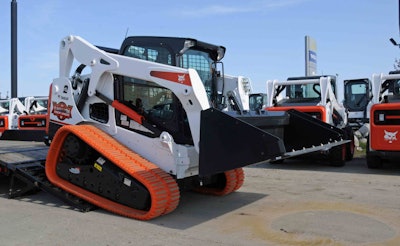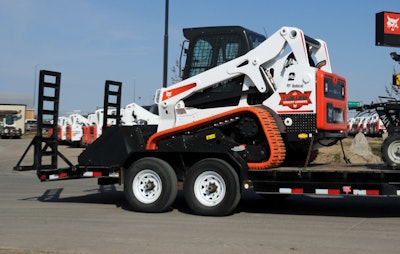 Before loading, make sure the ramp is sufficient for the job. With compact equipment, wooden ramps may splinter.
Before loading, make sure the ramp is sufficient for the job. With compact equipment, wooden ramps may splinter.Photo: Bobcat
Transporting a compact loader may seem like a simple task; however, moving compact equipment from one jobsite to another involves several steps that you and your employees do not want to overlook.
Using the steps below and following your owner’s manual will help you and your employees properly transport your compact loader to your next jobsite or back to your yard.
Select the right transport, towing vehicles
Be sure the transport and towing vehicles are of adequate size and capacity for the weight of the machine and attachments being transported.
“Trailers are an efficient way to properly transport compact loaders and attachments,” says Mike Fitzgerald, Bobcat loader product specialist. “Some smaller equipment can be transported on a 10,000-pound trailer, while larger equipment may require a 20,000 to 30,000-pound trailer or larger.
“With a compact loader and couple of attachments, you will most likely need a larger trailer with a larger weight rating to handle the load you are moving.”
Adequately designed ramps of sufficient strength (wood ramps can break and cause personal injury) are needed to support the weight of the machine when loading onto a transport vehicle.
Loading the machine
 Once the machine is loaded, lower the attachment to the floor of the trailer and secure chains according to your owner’s manual.
Once the machine is loaded, lower the attachment to the floor of the trailer and secure chains according to your owner’s manual.Photo: Bobcat
Always disengage the auto-idle feature (if equipped) when loading or unloading the machine on a trailer. Make sure mud, sand and any other debris are removed from the loader before loading the machine.
When you are ready to load the machine onto the trailer, travel up the ramp with the heaviest end up. The loader will be heavier in the rear than the front unless it is connected to an attachment, such as a breaker or planer, which will make it heavier in the front.
The rear of the trailer must be blocked or supported when loading or unloading the machine to prevent the front end of the trailer from rising up. Then, position the loader onto the trailer by the manufacturer’s guidelines.
Securing the loader
Once the machine is on the trailer, operators should lower the attachment to the floor of the trailer, stop the engine and engage the parking brake.
Install the chain at the front and rear loader tie-down positions, as identified by your owner’s manual. Then secure the chains and binders using recommended practices listed in the owner’s manual.
Following these steps, along with the instructions in your owner’s manual, will minimize problems the next time you transport your equipment to the jobsite.
Did you know?
Some companies are able to customize their trailers to accommodate their most commonly used attachments by adding side pockets or racks built to hold those attachments.
Operations that might benefit from a customized trailer include concrete removal companies that operate a hydraulic breaker or grapple bucket, or landscaping companies that use buckets to prepare sod or seed.
There are ways to accommodate a wide variety of attachments so businesses do not have to use multiple vehicles to move equipment and attachments from jobsite to jobsite.
This can add up to significant vehicle and fuel savings in the long run.
EDITOR’S NOTE: This column was provided by Bobcat Co. of West Fargo, North Dakota.










